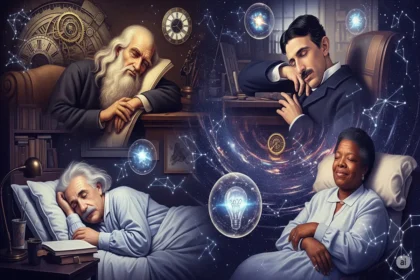It’s the kind of story that feels like it belongs in a dusty tome or whispered campfire tale: a secret sleep ritual, practiced by ancient monks, so powerful it was hidden from the masses. The “Forbidden Sleep Ritual” conjures images of cloaked figures meditating in torchlit caves, unlocking mystical states of rest and clarity. But what if this elusive practice isn’t just legend? What if it’s rooted in real, time-tested techniques from monastic traditions, and you could tap into its benefits tonight? Drawing on the disciplined sleep practices of Buddhist and Christian monks, let’s uncover the truth behind this so-called forbidden ritual and explore how you can adapt it to transform your nights into a source of calm, focus, and renewal.
Unraveling the Myth: What’s the “Forbidden” Ritual?
The idea of a “Forbidden Sleep Ritual” likely stems from the ascetic practices of ancient monastic orders, particularly in Buddhist and Christian traditions, where sleep was treated not as mere rest but as a spiritual discipline. In these communities, sleep wasn’t just about recharging—it was a gateway to mindfulness, self-mastery, and even divine connection. The “forbidden” label probably comes from the exclusivity of these practices, reserved for dedicated monks or deemed too intense for the average person. Think of Thai forest monks meditating without lying down to stay vigilant, or Benedictine monks rising at 2 a.m. for prayers during the “Night Office.” These weren’t secrets in the conspiratorial sense but rigorous disciplines that set monks apart from laypeople.
The ritual we’ll explore here isn’t a single, codified practice but a synthesis of monastic sleep techniques, blending mindfulness, intentional rest, and minimalism. It draws from the Buddhist concept of “wakeful sleep” (practicing awareness even in rest) and the Christian monastic tradition of structured sleep cycles, like those outlined in the Rule of St. Benedict. The goal? To sleep deeply, purposefully, and in harmony with your body and mind, achieving a clarity that carries into your waking life. I tried a version of this myself, and while it took a few nights to get the hang of it, the results—calmer nights, sharper mornings—were worth it.
The Science Behind Monastic Sleep
Modern science backs up why these ancient practices work. Monks often slept less than we do today, but their sleep was optimized for quality. Studies show that mindfulness-based practices, like those used by Buddhist monks, reduce cortisol (the stress hormone) and enhance slow-wave sleep, the deep, restorative phase that boosts memory and physical recovery. The structured sleep schedules of Christian monks, with their midnight prayer breaks, align with natural circadian dips, promoting segmented sleep—a pattern humans followed before electric lights, as historian Roger Ekirch has documented. This biphasic sleep (two chunks with a wakeful period) can enhance emotional processing and creativity, explaining why monks often described midnight hours as spiritually potent.
I was skeptical at first. As a parent with a packed schedule, the idea of adding “ritual” to my sleep felt like one more chore. But after a week of experimenting, I noticed I woke up feeling less frazzled, as if my sleep had been more intentional. The key was combining monk-like discipline with practical tweaks, making the ritual accessible without requiring a monastery.
The Forbidden Sleep Ritual: A Modern Take
Here’s how to recreate a version of this ancient practice tonight, blending monastic wisdom with science-backed strategies. It’s not about staying up all night meditating or chanting—it’s about preparing your mind and body for intentional, restorative rest. Think of it as a three-phase ritual: Prepare, Rest, and Reflect.
Phase 1: Prepare (The Mindful Wind-Down)
Monks didn’t just collapse into bed—they approached sleep with purpose, treating it as a sacred act. This phase sets the stage for deep rest by calming your mind and body.
Phase 2: Rest (The Monastic Sleep Setup)
Monks optimized their sleep environment and posture for minimal distraction and maximum restoration. This phase draws on their disciplined approach, including a nod to NASA’s zero-gravity position for physical ease.
Phase 3: Reflect (The Midnight Pause)
If you wake in the night, as monks often did, use it as a moment of clarity rather than frustration. This phase turns wakefulness into an opportunity for insight.
Practical Tips to Make It Stick
To weave this ritual into your life, try these monk-inspired strategies:
A Word of Caution
This ritual is intense by design, meant to mimic the discipline of monks, so it’s not for everyone. If you have insomnia, sleep apnea, or chronic stress, consult a doctor before trying segmented sleep or drastic changes. Back-sleeping may not suit those with certain health conditions (like acid reflux), so check with a professional if unsure. Also, avoid overhyped “monk secrets” online—stick to these evidence-based principles to avoid gimmicks.
The Power of Intentional Rest
The “Forbidden Sleep Ritual” isn’t about magic or mystery—it’s about reclaiming sleep as a deliberate act of renewal, just as monks did centuries ago. By preparing mindfully, resting purposefully, and reflecting during wakeful moments, you can turn your nights into a source of calm and clarity.
Tonight, dim the lights, breathe deeply, and try this ritual for yourself. You don’t need a monastery—just a willingness to treat sleep as more than a necessity. It’s a practice, a pause, a chance to connect with yourself. And who knows? You might wake up feeling a little closer to the wisdom of those ancient monks, ready to face your day with newfound focus.
Disclaimer: The information provided in this article is for general informational purposes only and does not constitute medical advice. It is not a substitute for professional medical advice, diagnosis, or treatment. Always seek the advice of your physician or other qualified health provider with any questions you may have regarding a medical condition. Never disregard professional medical advice or delay in seeking it because of something you have read on this website.
Disclaimer: These are the personal opinions of the author.













